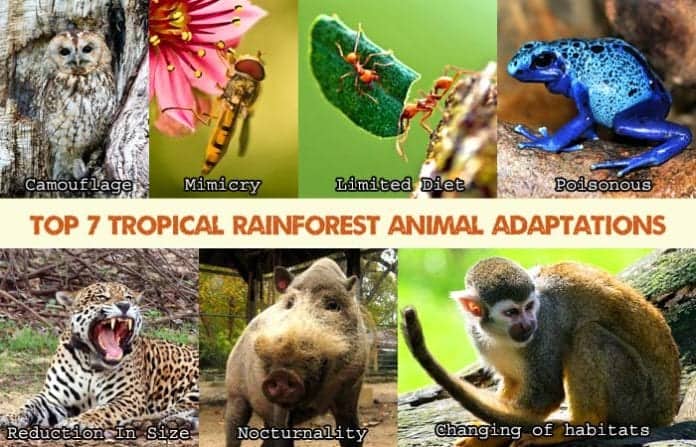
Tropical Rainforest Animal Adaptations: Tropical rainforests, because of their location near the equator, cover only a small area on our planet. Interestingly, this region is hugely oozing with biodiversity as it contains more than half of the world’s plant and animal species.
Table of Contents
The tropical rainforest is hot and humid, but the substantial amount of rainfall yearly makes it an ideal environment for life. But with great competition for natural resources, how do animals living in this environment adapt for survival?
In this article, let’s explore the top seven tropical rainforest animal adaptations: camouflage, mimicry, having a limited diet, poison, reduction of size and stature, and changing of habitats with illustrations.
Tropical Rainforest Animal Adaptations
1. Camouflage
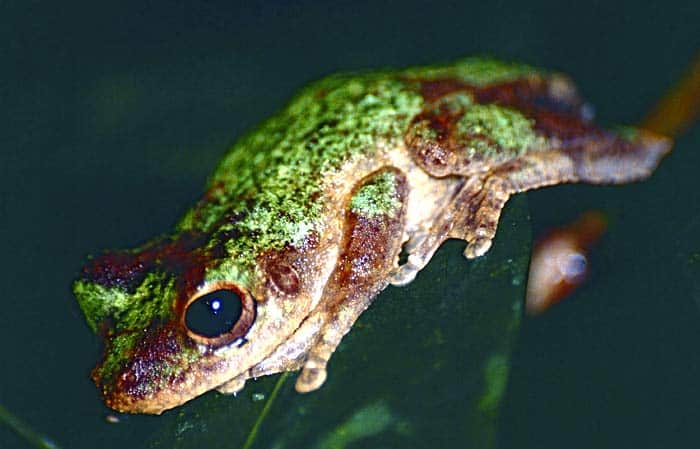
The first and most common animal adaptation in a tropical rainforest is camouflage[1]. For an animal to successfully exhibit this adaptation, it needs not only to have a color that will help it blend into the environment but also a shape that is unrecognizable by its predator.
- One good example of an animal practicing camouflage is the Green-eyed tree frog (Litoria genimaculata). This frog has developed flaps of textured skin around its body to resemble the barks of trees on its life.
- Another similar example is the Leaf-tailed Gecko (Phyllurus cornutus), which exhibits camouflage by having skin similar to tree bark covered with moss.
- Another good example is the young Southern Cassowary (Casuarius casuarius) which has an overall plumage color of light brown with stripes of black. Such adaptation helps the cassowary to blend in with the vegetation it lives on. During adulthood, the cassowary becomes fully black.
Despite being advantageous in escaping predation, hiding through camouflage bears little significance from a predator’s highly sensitive smell and impressive eyesight that can detect even the smallest movements its prey. Check out all about leopard geckos here.
![]()
2. Mimicry
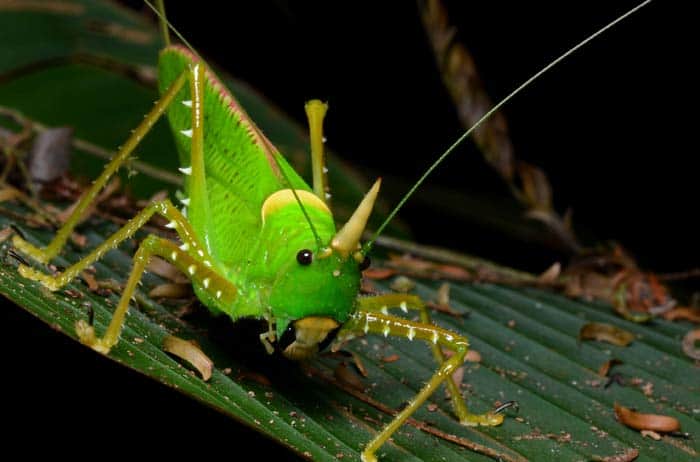
With the very dense vegetation and little amount of sunlight that can pass through the tree canopies, animals can easily hide in the rainforest. But instead of hiding, some animals resort to the adaptation called mimicry, where they tend to look like something that is intended to be seen[2] (and not hidden like camouflage).
- While seemingly alike at first glance, one major difference between camouflage and mimicry[3] is that the latter does not only involve the resemblance to the physical appearance but also to the behavior of other larger and more fearful organisms.
- An example of the animal exhibiting mimicry is a katydid (Aganacris pseudosphex), which not only appears like a stinging wasp but also behaves like it. Unlike the wasp with a venomous sting, the katydid is a harmless relative of grasshoppers and knows nothing about the venomous sting investments of a wasp.
The weirdest kind of mimicry is known as the Browerian mimicry[4], which involves the animal copying other animals of the same species. While this adaptation still confuses scientists, it is believed that it reduces the possibility of the predator eating its potential prey.
Suggested Reading:
Top 18 BEST Tundra Animal Adaptations
![]()
3. Having A Limited Diet
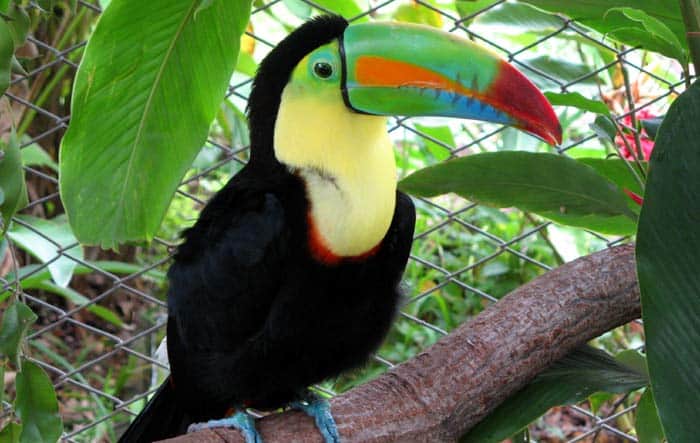
The rainforest is exceedingly full of natural resources, but the competition for these is also great. To avoid such competition, some animals have developed an adaptation wherein they reduce the choice of food[5] they consume.
- Most of the animals that have reduced their diet are the bird species. The Toucans[6] (Ramphastidae family) only consume fruits that other animal and even bird species cannot access. Along with this adaptation, their beak had to become long and narrow to open these fruits.
- Another example is the Leaf Cutter ants[7] (Tribe Attini), which are known for their ability to carry objects that are multiple times heavier than their bodies. Every day, they carry pieces of leaves from the high trees to their habitats underground. They bury these underneath the ground and consume the fungi that arise as the leaves decompose.
![]()
4. Poison
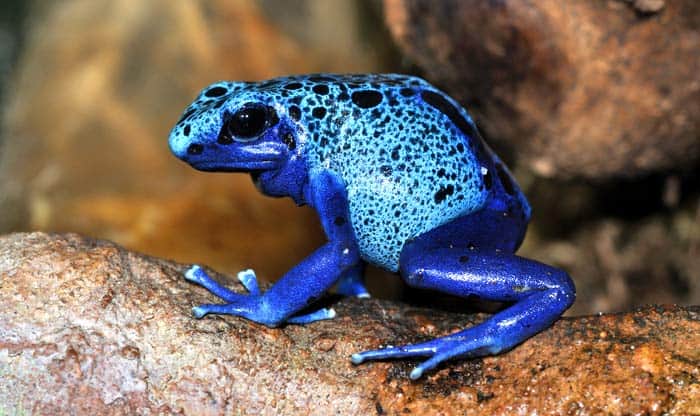
Aside from the production of poison per se, some tropical rainforest animals tend to have bright colors and distinct patterns to scare their predators.
- Poison dart frogs[8] (Family Dendrobatidae) come in very bright colors of yellow, red, green, and blue adorned with spots and swirl patterns. These bright colors indicate to predators that they need to stay away, or they will be poisoned. Interestingly, though, some dart frogs are not at all poisonous, but they remain unharmed because they look like their poisonous relatives.
- Lobster moths also exhibit this adaptation by looking like venomous scorpions during their larval stage. They have patterns in their wings that look like eyes, keeping them unharmed.
So instead of relying on hiding in the darkness and bark of trees, animals with poison can just freely hop without being bothered by being eaten.
![]()
5. Reduction of Size and Stature
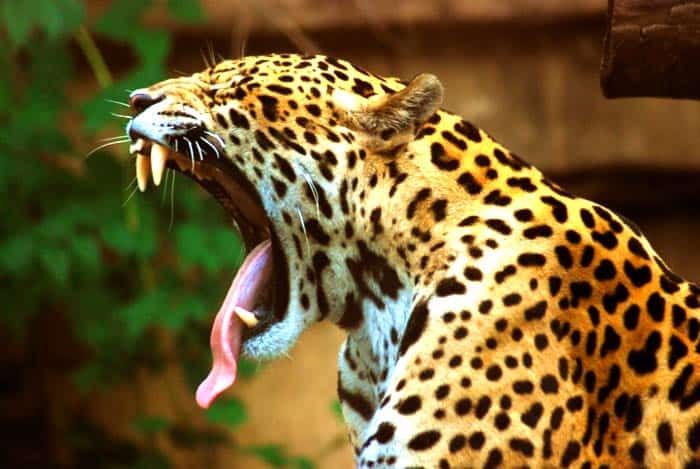
Despite being huge in terms of area, the tropical rainforest only favors smaller animals because its understory (the layer above the forest floor) is so dense that it makes large movements hard to execute. Hence, animals adapt to this by reducing their body size and stature.
- In a tropical rainforest, the jaguar (Panthera onca), the world’s largest species of cat, tends to grow only less than six feet long and weighs just about 200 pounds. Such a small build allows it to acquire the speed needed to hunt for food.
- However, snakes are an exception to this rule. Snakes in tropical rainforests can grow larger than anywhere else because they can fit in the spaces between trees and underground. Tropical rainforest snakes can grow up to 20 to 30 feet long
In general, the limited area for movement is one of the main reasons large animals like lions, zebras, giraffes, and elephants prefer to thrive in the savannas.
![]()
6. Nocturnality
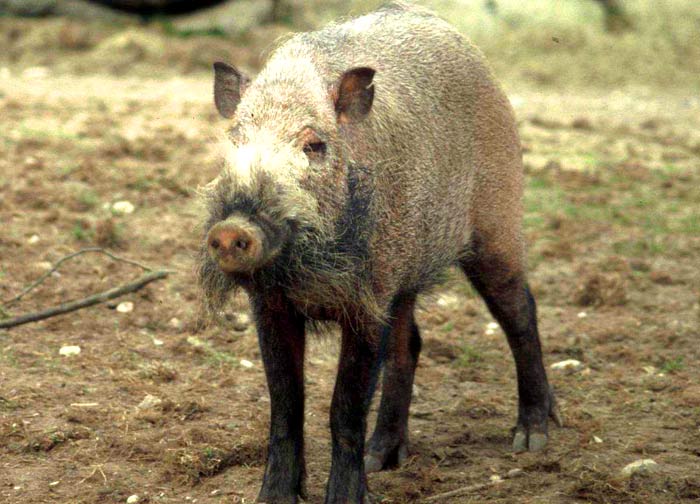
Another adaptation developed by rainforest animals is nocturnality. Nocturnal (unlike diurnal) animals are active at night and usually asleep or resting during the day.
- The bearded pig[9] (Sus burbatus) is a dark brown pig with a beard and somewhat resembles an Airedale terrier. While normally active during the day, pigs of these species resort to nocturnality when they migrate within the tropical rainforest. When they do this, they usually travel in groups (called herds) on the forest floor.
- On the other hand, from a predator’s point of view, nocturnality[10] provides a great advantage for food that seems to be nowhere during daytime (i.e., other nocturnal worms and mammals). Also, nocturnality reduces competition, as most predators hunt during the day.
Opting for nocturnality requires animals to enhance their other senses because sight is useless. Some animals have developed a stronger smell, better hearing, and other organs like heat-sensing ones.
![]()
7. Changing of Habitats
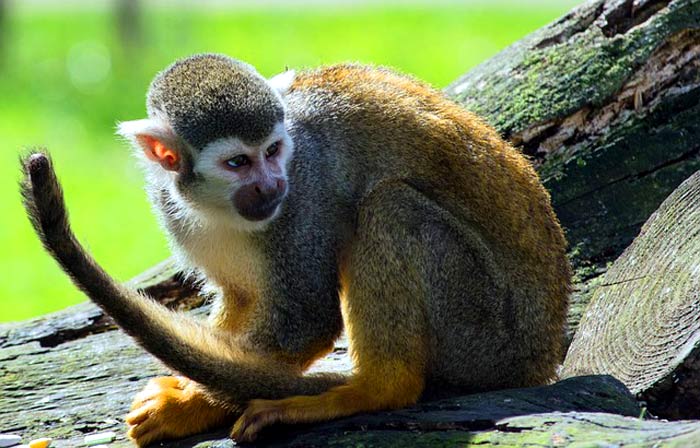
The tropical rainforest is home to numerous towering trees. Hence, to use this great advantage, some animals climb the canopies and live there.
- One example of this adaptation is the spider monkeys[11] (Genus Ateles)that have chosen to live at the tree canopies to avoid great competition in the under-story. These monkeys have developed tails capable of grasping, allowing them to swing freely among trees. Sloths that live by hanging upside down from high branches of trees are also an example.
- The rule of changing habitats is for animals to maximize their protection from predators and limit the competition for food.
![]()
Whether using camouflage, mimicry, production of poison, nocturnality, etc., being physically adapted to the environment is essential for animals residing in tropical rainforests. Indeed, the tropical rainforest is overflowing with such diversity and discovery; if only we have the eye to look for them.
Comment below if any tropical rainforest animal adaptations were missed.
![]()




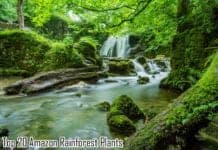
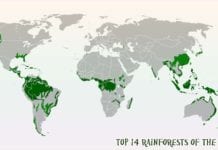
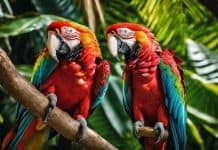

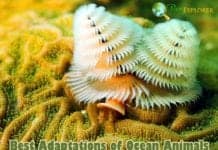















This was good. Thanks 🙂
this really helped a lot and I love using the website